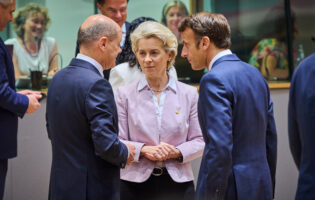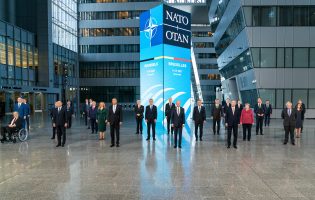Marking Milestones in German-American Relations

Jackson Janes
President Emeritus of AGI
Jackson Janes is the President Emeritus of the American-German Institute at the Johns Hopkins University in Washington, DC, where he has been affiliated since 1989.
Dr. Janes has been engaged in German-American affairs in numerous capacities over many years. He has studied and taught in German universities in Freiburg, Giessen and Tübingen. He was the Director of the German-American Institute in Tübingen (1977-1980) and then directed the European office of The German Marshall Fund of the United States in Bonn (1980-1985). Before joining AICGS, he served as Director of Program Development at the University Center for International Studies at the University of Pittsburgh (1986-1988). He was also Chair of the German Speaking Areas in Europe Program at the Foreign Service Institute in Washington, DC, from 1999-2000 and is Honorary President of the International Association for the Study of German Politics .
Dr. Janes is a member of the Council on Foreign Relations, the International Institute for Strategic Studies, the Atlantic Council of the United States, and American Purpose. He serves on the advisory boards of the Berlin office of the American Jewish Committee, and the Beirat der Zeitschrift für Außen- und Sicherheitspolitik (ZfAS). He serves on the Selection Committee for the Bundeskanzler Fellowships for the Alexander von Humboldt Foundation.
Dr. Janes has lectured throughout Europe and the United States and has published extensively on issues dealing with Germany, German-American relations, and transatlantic affairs. In addition to regular commentary given to European and American news radio, he has appeared on CBS, CNN, C-SPAN, PBS, CBC, and is a frequent commentator on German television. Dr. Janes is listed in Who’s Who in America and Who’s Who in Education.
In 2005, Dr. Janes was awarded the Officer’s Cross of the Order of Merit of the Federal Republic of Germany, Germany’s highest civilian award.
Education:
Ph.D., International Relations, Claremont Graduate School, Claremont, California
M.A., Divinity School, University of Chicago
B.A., Sociology, Colgate University
Expertise:
Transatlantic relations, German-American relations, domestic German politics, German-EU relations, transatlantic affairs.
__
In advance of a new year, milestones can be a preoccupation of those looking ahead for guidance. 2013 offers a few such markers in German-American relations. They can both contrast and compare where we have been and what has changed, while perhaps even suggest what is ahead.
In June there will be a ceremony marking the 50th anniversary of the speech President Kennedy delivered in Berlin in 1963. The famous “ich bin ein Berliner” line became instantly iconic and most Germans sixty and older remember its importance less than two years after the Berlin Wall had divided the city. That speech became further immortalized after Kennedy was murdered five months later.
That same year — 1963 — was the stage for the famous Elysee treaty between France and Germany, which was to be the symbol of Franco-German reconciliation. However, the treaty would also serve as the cornerstone of the European project during the next half century — a project that has been equally important for transatlantic relations.
Another milestone to be remembered next June will be the protests of East Germans against the dictatorship of the communist puppets put in place by the Soviet Union sixty years earlier. For decades, June 17 was marked by West Germans as a day to remember that brief attempt to challenge the East Berlin regime, one that could only be crushed by Russian tanks. It would be another thirty-seven years before East Germans were able to enjoy the freedom they sought in 1953. In 1990, German unification represented the fulfillment of a commitment embedded in the Basic Law of the Federal Republic of Germany and supported by its alliance partners. It was also a reminder of the relentless demand for freedom and justice no matter how long it takes to achieve.
In addition to remembering these milestones — and as different as the situations were — we are supposed to draw lessons from these historical markers for the future. Looking ahead to the coming year, we can see both consistency and change in the challenges and choices both the U.S. and Germany face. They are in many ways related to those of the past. And in each of these milestones we can see lessons for Germany, the European project and for German-American relations.
Ich bin ein Berliner
The 1963 Kennedy speech was aimed at reassuring West Berliners that the United States was committed to their protection in their walled-in city and indeed to the western alliance in which West Germany was the front line. The fact that Kennedy had accepted the erection of the wall two years earlier generated much suspicion among Germans that the Americans might not stand by that commitment. Kennedy had actually stared down Soviet leader Nikita Khrushchev months before over the Cuban missile crisis. Yet Kennedy had made his first and last visit to West Berlin to boost morale there while also recognizing that the Cold War stand off was both a long-term and a global confrontation in which Germany was a strategic platform. Kennedy saw the pursuit of German unification as at best a long-term goal in a world in which the east-west divide seemed as hard as the cement wall running through Berlin. But his speech laid down a marker for Germans, Russians and Americans that underlined U.S. resolve in maintaining its commitment to the protection of West Berlin as evidence of its larger commitment to the Federal Republic and the western alliance.
Fifty years later, German-American relations are no longer defined by walls in Germany, but rather by the walls and confrontations of others well beyond Germany’s borders. For the United States, Germany is no longer a primary strategic base but rather a strategic partner in confronting challenges and choices in Europe and around the globe. In turn, Germany no longer must rely on American trip wire troops in Berlin to protect itself from aggression, but rather must itself help to provide protection to others threatened today ¾ be it within Europe, the Middle East, Africa, or elsewhere around the globe.
Both Germany and the United States are facing challenges that have been changing the equation of their relations ever since German unification over two decades ago. The vast web of interests, policies and institutions surrounding German-American relations is today part of a much larger framework in which Germany’s role has been transforming into a leader in Europe and on the global stage. In turn, the United States has seen its interests and policies increasingly shaped by events and forces beyond Europe, be it in Iraq, Iran, Afghanistan, or directed at the Pacific arena.
That Germany and the United States share certain needs is evident. But how and why Germany and the United States need each other is different than a half century ago. Those differences include areas of disagreement in both framing their needs, as well as the policies to deal with them. The dialogue between Berlin and Washington in the coming years will be about sorting out both the continuities and the changes involved in this evolving equation. In the coming year, the many issues that will shape the foreign policy dialogue will include how to deal with Russia, the civil war in Syria, the uncertain path of Egypt as well as its Arab neighbors and Israel, and the Iranian nuclear ambitions. It will also include plotting a course of relations with China and India.
Besides these strategic foreign policy challenges, the Berlin-Washington dialogue will also be shaped by a continuing need to strengthen the economic framework in which so much common ground is found. The push to forge a comprehensive economic agreement between the EU, Canada and the U.S. is on top of agendas on both sides of the Atlantic, and it could lend itself to redefining the future the transatlantic community. With so much attention having been focused on what is seen as an American “pivot” to the Pacific, the enormous mutual economic investment across the Atlantic remains a dominant force on the world stage and can be made that much more significant though the development of a more extensive and integrated market place for over eight hundred million people making up half the world’s GDP. Such an agreement can also help develop common ground on dealing with challenges such as cyber security as well as shared research and development in critical areas such as energy, pharmaceuticals and transportation.
Over a half century, the German-American dialogue has continually evolved to adjust to new realities. In 1963, Germany was an important dimension of America’s Cold War foreign policy, with West Germany dependent on the U.S. for its strategic security while also playing a supporting role in the initial steps of European integration. Now, in 2013, Germany has far different security needs, as it is less dependent on the U.S. and plays a lead role — in some ways THE lead role — in a European Union increasingly expanding its membership and capabilities. While there remains a multi-level network of interdependence with the United States, Germany today has challenges and choices it did not face in 1963.
Similarly, the United States does not see Germany as the pivot of a bi-polar military confrontation, but rather as a player in a strategy aimed at global challenges dealing with a demographic changes, energy resources, agricultural scarcity, environmental dangers and continued threats of terrorism around the globe.
Germany’s European responses
Responding to these challenges, Berlin will prefer to be shaping its policy in the framework of the European Union in order to strengthen the capacity of an EU foreign policy approach, so far as that is feasible. The U.S. will be looking for capabilities or “deliverables,” but there remains more skepticism than belief in Washington that a common European platform will prove to be consistently dependable. The case of Libya remains a reminder of that challenge for Europeans in general and for Germany in particular. That challenge also carries with it the seeds of friction both with the U.S. as well as within the EU in forging common policy positions.
At the same time, the view from Europe over the Atlantic includes a United States having to cope with both increasing domestic constraints, as well as a diffusion of global power shifting its capacities in a changing international order. While the role of the U.S. remains a dominant one on the world stage, there are indications that its ability to exercise leadership across multiple scenarios is gradually receding. There will be a corresponding need to assemble strategic partnerships to deal with global challenges. Clearly Europe is one if those partners. Yet the challenge facing the European project is its own capacity to move further toward its goals of creating a stronger union. Amidst the current struggles over the euro and the structural problems facing its members, the EU is at a major turning point. At the heart of Europe’s future has been and remains the Franco-German relationship. Without that bond, the EU would not have evolved as far as it has to date.
Yet as the fiftieth anniversary of the Elysee Treaty is marked on Jan 22, the blueprint presented in Paris fifty years ago is in need of renewal. Increasing the capacity of Europe as a partner and actor on the global stage will depend on a renewal of the European project not only at the levels of leaders, but also at the level of those millions of Europeans with doubts about their respective futures. While there can be no doubt that Germany will play a lead role in overcoming the current crises, Berlin will not choose to act unilaterally. Both history and necessity will make a bridge with Paris a requisite for the future of Europe regardless of differences in policies, personalities and perspectives. While Germany’s influence in Europe has increased over the past two decades since unification, France remains committed to the European project — more than the current United Kingdom appears today. The EU may not look like it does now in another decade, but the Franco-German foundation will remain a central part of it.
The legacy of the Franco-German partnership also influences Berlin’s relations with other key partners — including Warsaw and Prague, both of which also symbolize the new chapters in European history in terms of both reconciliation and renewal. In the words of Konrad Adenauer in 1963, the treaty of Elysee was at its core about trust. That has been a strong basis of the European project for the past half century. Today that basis needs to be renewed.
The Spring of 1953 and 2013
Sixty years after the short-lived attempt to challenge the forces of dictatorship in East Germany, remembering the courage of those who faced Soviet tanks then should also point toward further examples of determination over the next four decades in Budapest, Prague, Warsaw, Bucharest, Beijing, and Moscow among others. This courage continued elsewhere in Europe in the Balkans and then more recently appeared across an arc of Arab countries in the wink of an historical eye. There were comparisons with the revolutions in Eastern Europe twenty years earlier. Yet history does not repeat itself, even though it might appear at times to rhyme.
Decades earlier, the challenges to communist dictatorships in Eastern Europe were heard but not helped by those in the West. The Cold War playbook prevented aid to the freedom fighters in Hungary or Czechoslovakia. It was to be the courage of those Poles surrounding the Gdansk shipyards that not only challenged the generals in Warsaw and Moscow, but also the governments in Western Europe and in Washington to support the calls for support of Solidarity. Yet even then, in another part of the world, no one ventured to help those to be slaughtered in Rwanda, followed by Srebrenica a few years later.
In looking back on the constraints imposed by the rules of the Cold War, we should ask what lessons need to be drawn for today’s fronts in which people need help to secure for themselves what other’s take for granted. How different are the constraints today? What can be done today that was not possible a half century ago? Whose responsibility is it to protect whom?
One more milestone
AGI will mark its 30th year in 2013. We have tracked developments of the last three decades as they shaped first the two German states and then resulted in the historical moment of unification in 1990. We chronicled the efforts needed to reconnect millions of Germans with each other after forty years of division. We examined how a united Germany sought to help build a larger Europe, while also seeking to allay concerns about its role in that expanding enterprise. We studied relations between Germany and Russia, Ukraine, Turkey, Israel, China, and France. We compared how Germany and the United States deal with the challenges of social security, health care, the role of religion, immigration, energy, and our domestic economic challenges. We have drawn lessons from each side of the Atlantic in looking at our political systems at work, watching elections and engaging political leaders.
Throughout these thirty years, we have focused our efforts on looking at the choices and challenges Germany and the United States face, evaluating both the consequences which emerge, and drawing conclusions which we hope prove valuable to those audiences we address on either side of the Atlantic. We do this because we are committed to making the dialogue between two countries — ones that share a unique past and present — as transparent and informed as possible. History informs us what happens when that effort fails between any two nations. We do what we can to make a better future possible. 2013 will continue that mission.








